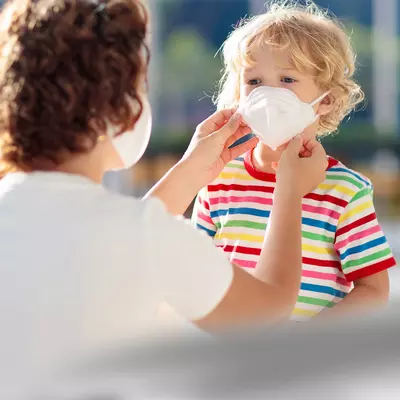- AdventHealth

While you’re spending more time on the home front during a coronavirus quarantine, you have several options for occupying your time. And if you’re like some folks, you’re feeling ambitious with the extra time on your hands.
Many people are turning to home improvement or construction projects while weathering the coronavirus pandemic. Especially when tackling a new task, personal safety should be a top priority. But in this time of the coronavirus pandemic, when hospital space is precious and resources need to be devoted to COVID-19 patients, safety precautions are more important than ever.
Whether it’s a renovation or a new creation, take steps to protect yourself while working on that long-awaited project.
Take Precautions Before You Begin
Many unintentional injuries are preventable. Keep these safety tips in mind as you do it yourself (DIY) with a new project:
- Eliminate tripping hazards like tool cords, small craft pieces and more
- Poison-proof your project, and be sure to safely store any chemicals or materials that are harmful if touched or swallowed
- Practice fire safety by checking your electrical cords for fraying or exposed wires and make sure any heat-producing tools are stored safely
- Wear the proper protective gear, like helmets, gloves and goggles that protect body parts that could be harmed
Give Your Tools a Checkup
If your project requires tools, be sure to educate yourself on using them safely and properly before you begin your work.
The United States Occupational Safety and Health Administration (OSHA) recommends the following general safety steps when working with any tool:
- Keep your tools in good working condition
- Make sure you’re using the right tool for the job
- Read the manufacturer’s instructions before you operate each tool
If your project requires a ladder (finally repainting your ceiling, for example), OSHA has special recommendations for safety, including:
- Don’t stand on the top step or rung of a ladder unless it was designed for that purpose
- Maintain a three-point contact on the ladder when climbing (two hands and a foot or two feet and a hand)
- Place your ladder on a stable, level surface
If you’ll be working with a chainsaw (finally chopping down that ominously leaning tree, for instance), the Centers for Disease Control and Prevention (CDC) has special instructions, including:
- Always cut at or below waist level
- Keep bystanders at a safe distance
- Take extra care in cutting trees or branches that are bent or twisted
Use Proper Lifting Form
Maybe your DIY project is less cut-and-paint and more clean-and-organize. If so, there are still some necessary precautions that will help keep you safe.
When rearranging closets or furniture, lift heavy objects using proper form:
- Before lifting anything, assess its weight by pushing on it lightly with your hands or feet
- If the object you’re lifting has handles or straps, use them as you lift
- Lift with your arms, legs and abdominal muscles instead of your back
- Try to avoid jerky or twisted movements when you lift and carry something
Be Safe With Your Cleaners
If your project requires heavy-duty cleaning, you may be working with bleach — an effective tool for sanitizing. The CDC has some recommended guidelines for using this chemical, including:
- Never mix bleach with ammonia or any other cleaner
- Open windows and doors to allow ventilation if you’re using bleach indoors
- Wear rubber or nonporous boots, gloves and goggles
Decorate Safely for Birthdays
Just because we’re staying inside doesn’t mean we can’t continue to celebrate. If you’re feeling festive for a birthday or just because, make sure you’re decorating safely. The U.S. Consumer Product Safety Commission recommends taking these steps:
- Balloons can be fun, but don’t allow kids under age 8 to play with uninflated balloons unsupervised, as they pose a choking hazard
- Check each set of lights for cracked sockets, loose connections or frayed wires
- If using an extension cord, don’t use more than three standard-size light sets per cord
- Try to use paper materials that are labeled “flame-resistant” or “noncombustible”
- Use non-flammable candle holders and keep candles away from paper and other decorations
Follow Cooking Safety Basics
Becoming a baker with all the extra time at home due to the coronavirus pandemic? Finally figuring out how to use a kitchen appliance that’s been collecting dust on a shelf? Whatever you’re cooking up, do it safely with these CDC tips:
- Before peeling, wash fruits and vegetables thoroughly
- Throw out foods left unrefrigerated for more than two hours
- Wash cutting boards, utensils and countertops with hot, soapy water
- Help prevent food poisoning by washing your hands before and after handling food (scrub the backs of your hands, under your nails and between your fingers)
Know Wound Care Steps
Of course, even if you take all the proper safety steps, accidents happen sometimes. If you find yourself with a wound, follow these steps, as outlined by the CDC:
- Check on your tetanus immunization records using the AdventHealth app
- If the wound swells, drains or gets red, seek immediate medical help
- Immediately clean any open wound with soap and clean water, and then cover it with a clean, dry bandage
If a wound is serious, you can do a video visit with a doctor through the AdventHealth app, which is available on your smartphone or tablet. To help prevent the spread of COVID-19, you should avoid the emergency department at your local hospital except in the event of a medical emergency.
Through a telehealth video visit in the AdventHealth app, our providers can advise you on what to do next for a severe wound or injury.
Helping You Stay Safe
For more tips on coping with the coronavirus pandemic and how to stay safe, visit our Coronavirus Resource Hub. We’re continually updating this site with important news about COVID-19 that can help you stay healthy, safe and informed.



